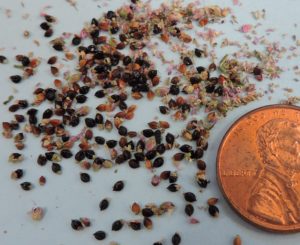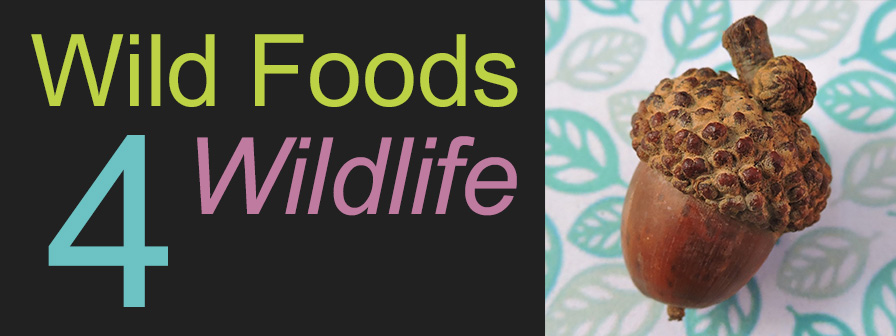
The list below ranks in order the top 75 favorite wildlife preferred seeds.
The ranking is determined using two criteria to describe the role of the plant food in animals’ diets:
1) the number of species that utilizes the food,
2) how significant the food is within an individual species overall diet
So while a food may not be popular across a large number of species, it still could be strongly preferred by a few species. By coordinating with a rehabber’s specific needs, a forager can decide which plants to best target for collection.
Be sure to check any item listed below in the database to see if there are any toxicological warnings associated with that plant or part of the plant.
| Common Name | Botanical Name | |
| 1 | smartweed (knotweed) | Polygonum spp. |
| 2 | ragweed | Ambrosia spp. |
| 3 | bristlegrass | Setaria spp. |
| 4 | pine | Pinus spp. |
| 5 | sedge | Carex spp. |
| 6 | bulrush | Scirpus spp. |
| 7 | millet, wild | Echinochloa spp. and others |
| 8 | panicgrass | Panicum spp. |
| 9 | switchgrass | Panicum virgatum |
| 10 | pondweed | Potamogeton spp. |
| 11 | birch | Betula spp. |
| 12 | sunflower | Helianthus spp. |
| 13 | spruce | Picea spp. |
| 14 | bluegrass | Poa spp. |
| 15 | elm | Ulmus spp. |
| 16 | widgeongrass | Ruppia maritima |
| 17 | wild rice | Zizania spp. |
| 18 | maple | Acer spp. |
| 19 | dock | Rumex spp. |
| 20 | pigweed (amaranth) | Amaranthus spp. |
| 21 | crabgrass | Digitaria spp. |
| 22 | sweetgum | Liquidamber styraciflua |
| 23 | spikerush | Eleocharis spp. |
| 24 | hemlock | Tsuga spp. |
| 25 | clover | Trifolium spp. |
| 26 | waternymph (naiad) | Najas spp. |
| 27 | maple, box elder | Acer negundo |
| 28 | chickweed, common | Stellaria media |
| 29 | wild celery | Apium graveolens |
| 30 | timothy | Phleum pratense |
| 31 | waterlily | Nymphaea spp. |
| 32 | dandelion, common | Taraxacum officinale |
| 33 | spruce, black | Picea mariana |
| 34 | lamb’s quarters | Chenipodium album |
| 35 | sycamore, American | Platanus occidentalis |
| 36 | goldenrod | Solidago spp. |
| 37 | alder | Alnus spp. |
| 38 | arrowhead | Sagittaria spp. |
| 39 | ash | Fraxinus spp. |
| 40 | teasel | Dipsacus spp. |
| 41 | thistle | Carduus spp. |
| 42 | thistle | Cirsium spp. |
| 43 | poplar, tulip | Liriodendron tupilfera |
| 44 | eelgrass | Zostera spp. |
| 45 | wood sorrel | Oxalis spp. |
| 46 | coon’s tail | Ceratophyllum demersum |
| 47 | buttercup | Ranunculus spp. |
| 48 | magnolia | Magnolia spp. |
| 49 | bur-reed | Sparganium spp. |
| 50 | flatsedge | Cyperus spp. |
| 51 | teasel, Fuller’s | Dipsacus fullonum |
| 52 | hornbeam, American | Carpinus caroliniana |
| 53 | cordgrass | Spartina spp. |
| 54 | violet | Viola spp. |
| 55 | cornflower (knapweed)(starthistle) | Centaurea spp. |
| 56 | dropseed grass | Sporobolus spp. |
| 57 | crowngrass | Paspalum spp. |
| 58 | sawgrass, Jamaican | Cladium mariscus |
| 59 | clover, white | Trifolium repens |
| 60 | elm, American | Ulmus americana |
| 61 | locust, black | Robinia pseudoacacia |
| 62 | sweet bay | Magnolia virginiana |
| 63 | rice cutgrass | Leersia oryzoides |
| 64 | honeylocust | Gleditsia triacanthos |
| 65 | cosmos | Cosmos spp. |
| 66 | larch | Larix spp. |
| 67 | purslane | Portulaca spp. |
| 68 | basswood, American | Tilia americana |
| 69 | brome | Bromus spp. |
| 70 | vetch | Vicia spp. |
| 71 | tamarack | Larix laricina |
| 72 | redbud, eastern | Cercis canadensis |
| 73 | mullein | Verbascum spp. |
| 74 | horned-pondweed | Zannichellia palustris |
| 75 | aster | Aster spp. |
What Criteria is Used for the Ranking the Lists?
The main resources used to build this website usually rated foods in three levels of preference: high, middle and low. But, a plant may be high preference in Michigan but lower preference in Virginia. So the preference factor has some built in limitations. Still, it is factor #1 in the algorithm.
The second factor considered was how many species of animals ate the part of the plant in consideration. A seed that 29 species of animals eats would outrank a seed that only 5 species eats.
From a foragers perspective, it would be ideal to collect the most highly preferable foods that feed the widest range of rehabilitation animals, right? Well maybe not.
Consider if a rehabilitator only works with foxes. To research which foods would be most beneficial in the “fox only” scenario, the only consideration that she would care about is the most preferred food for foxes, not how many other species ate it.
So the ranking lists are the most general broad interpretation of the data. You will want to generate your own lists from the search feature to find out just what you want to target for collection.
References Used with Permission:
The Fire Effects Information System, U.S. Department of Agriculture, Forest Service, Rocky Mountain Research Station, Fire Sciences Laboratory (Producer).
Fire Effects Information System (2017) Plant species ecology literature reviews. Retrieved various dates from https://www.feis-crs.org/feis/
Martin, A.C., Zim, H.S., Nelson, A.L. (1951). American Wildlife and Plants: A Guide to Wildlife Food Habits. New York: Dover Publications.
Scott, M. (2013). Songbird Diet Index. National Wildlife Rehabilitators Association, St. Cloud, MN.
